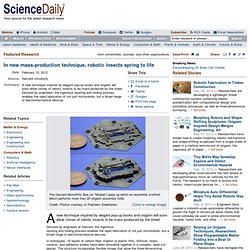

In space and on Earth, why build it, when a robot can build it for you? Like something straight out of "Star Wars," armies of robots could nimbly be crawling up towers and skyscrapers to make repairs in the not-so-distant future, so humans don't have to.

That's just one thing researchers in Hod Lipson's Creative Machines Lab envision with their latest robot prototype. It can autonomously traverse and manipulate a 3-D truss structure, using specially designed gears and joints to assemble and disassemble the structure as it climbs. Lipson is an associate professor of mechanical and aerospace engineering, and of computing and information science at Cornell University. In new mass-production technique, robotic insects spring to life. A new technique inspired by elegant pop-up books and origami will soon allow clones of robotic insects to be mass-produced by the sheet.

Devised by engineers at Harvard, the ingenious layering and folding process enables the rapid fabrication of not just microrobots, but a broad range of electromechanical devices. In prototypes, 18 layers of carbon fiber, Kapton (a plastic film), titanium, brass, ceramic, and adhesive sheets have been laminated together in a complex, laser-cut design. The structure incorporates flexible hinges that allow the three-dimensional product -- just 2.4 millimeters tall -- to assemble in one movement, like a pop-up book. The entire product is approximately the size of a U.S. quarter, and dozens of these microrobots could be fabricated in parallel on a single sheet. "This takes what is a craft, an artisanal process, and transforms it for automated mass production," says Pratheev Sreetharan (A.B. '06, S.M. '10), who co-developed the technique with J.
Future of Farming: Prospero Robot Farmer.